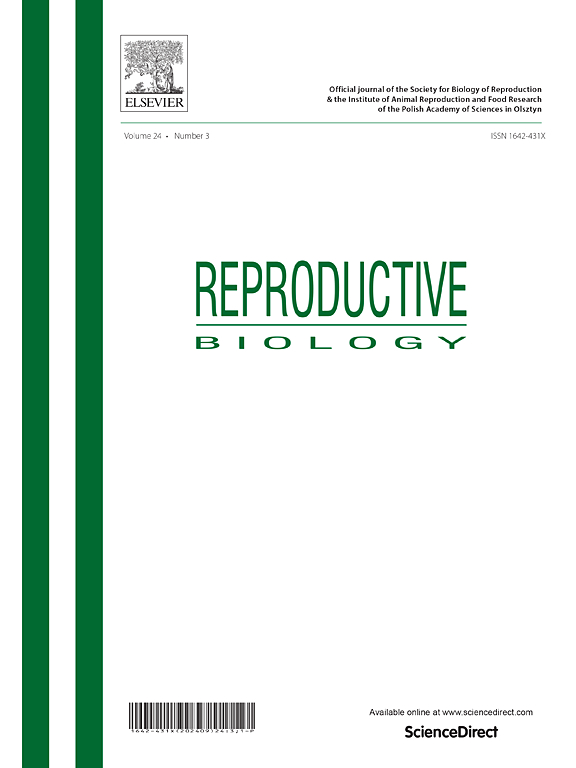Dummerstorf超育小鼠系的特殊表型特征可能与igf轴基因的表达水平有关
IF 2.5
3区 生物学
Q3 REPRODUCTIVE BIOLOGY
引用次数: 0
摘要
迄今为止,具有生殖表型的动物模型是基因敲除或转基因的,通常表现为生育力降低或不育。这限制了对单基因影响或生育能力丧失的研究。相比之下,Dummerstorf高育性小鼠系1和2 (FL1和FL2)是两种独特的远交选择模型,表现出卓越的生殖性能。经过大约50年的选择,两个品系每个周期的排卵卵母细胞数量都增加了一倍,因此它们的产仔数(>20 vs ~ 11)与未选择的相同创始种群(Dummerstorf FZTDU,对照线)相比。FL1和FL2表现出非典型的发情周期长度和激素水平的改变,如胰岛素和瘦素,这与GnRH释放和/或体脂含量增加有关。与这些因素影响生育能力的典型情况不同,它们反而有助于fl的高生殖能力:排卵率的增加是由于卵母细胞质量的提高,受不同卵巢脂质谱的影响。在本研究中,我们分析了与生殖性能和fl特异性性状相关的igf轴标记基因在三种组织中的表达。我们发现,在胚胎植入过程中起关键作用的lepr在FL1子宫中表达上调(1.5倍,p <; 0.05)。在FL1卵泡中,igf1、igf结合蛋白(IGFBP2、IGFBP4)和参与配子发生的hsf1显著上调(1 - 4倍于对照,p <; 0.05);P <; 0.01,igfbp2)。在FL2中,子宫尺寸相对于体重减小(FL2为0.2 %,对照组为0.25 %,FL1为0.28 %,p <; 0.001),表明子宫尺寸不会导致产仔数的增加。这些发现为研究高育性的分子基础提供了新的见解,并可为进一步研究生殖生物学中基因型-表型关系奠定基础。本文章由计算机程序翻译,如有差异,请以英文原文为准。
The special phenotypic characteristics of Dummerstorf superfertile mouse lines could depend on the expression levels of IGF-axis genes
To date, animal models with reproductive phenotypes are knockout or transgenic and typically exhibit reduced fertility or infertility. This limits research to studying single-gene effects or loss of fertility. By contrast, Dummerstorf high-fertility mouse lines 1 and 2 (FL1 and FL2) are two unique outbred selection models that demonstrate exceptional reproductive performance. After approximately 50 years of selection, both lines have doubled the number of ovulated oocytes per cycle and consequently their litter size (>20 vs ∼11) compared to the unselected mice of the same founder population (Dummerstorf FZTDU, ctrl line). FL1 and FL2 exhibit atypical estrous cycle length and altered levels of hormones, such as insulin and leptin, which are associated with GnRH release and/or increased body fat content. Unlike typical cases where these factors impair fertility, they instead contribute to the FLs’ high reproductive capacity: the increased ovulation rate results from an upgrade in the quality of their oocytes, influenced by different ovarian lipid profile. In the present study, we analyzed the expression of IGF-axis marker genes linked to reproductive performance and FL-specific traits in three tissues. We found that lepr, which plays a critical role in implantation, was upregulated in the FL1 uterus (1.5-fold vs. ctrl, p < 0.05). In FL1 follicles, igf1, IGF-biding proteins (IGFBP2, IGFBP4) and hsf1—which is involved in gametogenesis—were significantly upregulated (1–4-fold vs. ctrl, p < 0.05 for igf1, hsf1 and IGFBP4; p < 0.01 for igfbp2). In FL2, uterine size was reduced relatively to the body weight (∼0.2 % FL2 vs. 0.25 % in ctrl and 0.28 % in FL1, p < 0.001), indicating that uterus dimensions do not drive their increased litter size. These findings provide new insights into the molecular basis of high fertility and could serve as a foundation for further studies on genotype-phenotype relationships in reproductive biology.
求助全文
通过发布文献求助,成功后即可免费获取论文全文。
去求助
来源期刊

Reproductive biology
生物-生殖生物学
CiteScore
3.90
自引率
0.00%
发文量
95
审稿时长
29 days
期刊介绍:
An official journal of the Society for Biology of Reproduction and the Institute of Animal Reproduction and Food Research of Polish Academy of Sciences in Olsztyn, Poland.
Reproductive Biology is an international, peer-reviewed journal covering all aspects of reproduction in vertebrates. The journal invites original research papers, short communications, review articles and commentaries dealing with reproductive physiology, endocrinology, immunology, molecular and cellular biology, receptor studies, animal breeding as well as andrology, embryology, infertility, assisted reproduction and contraception. Papers from both basic and clinical research will be considered.
 求助内容:
求助内容: 应助结果提醒方式:
应助结果提醒方式:


